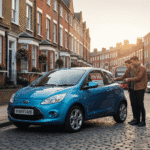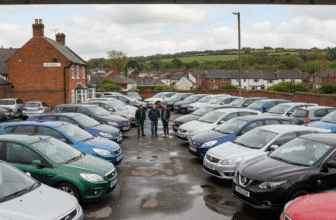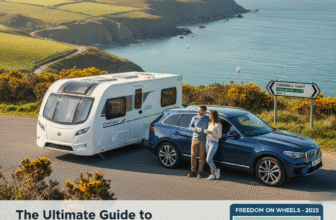
Ford Ka for Sale: The Ultimate UK Buyer’s Guide to a City Car Legend
For over two decades, the Ford Ka has been a quintessential part of the British motoring landscape. From its quirky, love-it-or-hate-it debut to its more practical final form, the Ka has consistently offered affordable, fun, and characterful transport for the masses. Whether you’re a first-time driver hunting for a car with low insurance, a city dweller needing a nimble runabout, or simply someone looking for a bargain set of wheels, finding a Ford Ka for sale is often the perfect solution.
But with three distinct generations, each with its own personality, quirks, and potential pitfalls, navigating the used market can be a daunting task. Which one is right for you? What should you look for? And how much should you really be paying? Fear not. This is your ultimate, comprehensive guide to buying a used Ford Ka in the UK. We’ll break down each generation, arm you with a rock-solid inspection checklist, and give you the confidence to find a brilliant little car for a brilliant price.
The Three Faces of Ka: A Generation-by-Generation Breakdown
The Ford Ka’s story is one of evolution. It started as a radical design statement and ended as a pragmatic budget supermini. Understanding the differences between the three main models is the first step to finding your perfect match.

The Original Icon (Mk1: 1996–2008) – The Go-Kart
When the first Ford Ka rolled onto our roads in 1996, it looked like nothing else. Penned under Ford’s “New Edge” design philosophy, its combination of sharp angles and bubbly curves was a bold move that paid off handsomely. It was instantly recognisable, cheeky, and brimming with a youthful energy that many of its bland rivals lacked.
The Driving Experience: If you ever hear someone talk about a car having “go-kart handling,” they were probably thinking of the original Ka. With a wheel placed at each corner, minimal overhangs, and brilliantly direct steering, the Mk1 is an absolute joy to drive. It zips through city traffic with glee and can be genuinely entertaining on a winding B-road. It’s a car that constantly reminds you that driving can, and should, be fun.
Engines and Performance: For most of its life, the Mk1 was powered by the rather ancient but dependable Endura-E 1.3-litre petrol engine. It’s not fast by any stretch of the imagination, but it’s perfectly adequate for town driving. In 2002, this was replaced by the smoother and slightly more modern 1.3-litre Duratec engine, which is the one to go for if your budget allows. The real stars, however, were the performance models. The SportKa, with its punchy 94bhp 1.6-litre engine and sporty styling, and the jaunty two-seater convertible, the StreetKa, offered a significant performance boost and are now bona fide modern classics.
What to Watch Out For: There is one word that every prospective Mk1 Ka buyer needs to burn into their memory: RUST. These cars can corrode with alarming enthusiasm. The key areas to inspect with a fine-tooth comb are:
- The fuel filler cap: This is the number one spot. Prod gently around the entire plastic housing. If it feels crispy or you can see bubbling paint, serious rot is likely hiding underneath.
- The sills: Check the entire length of the sills underneath the doors. They can look fine on the outside but be rotten from the inside out.
- Wheel arches: Both front and rear arches are prone to bubbling and rust.
- Door bottoms and boot floor: Lift the carpets and check for any signs of dampness or corrosion.
Mechanically, they are fairly robust, but listen for rumbling wheel bearings and knocking sounds from the suspension, which can indicate worn bushes. On the older Endura-E engines, check the oil filler cap for a creamy, mayonnaise-like substance, a tell-tale sign of head gasket failure.
Why Buy One Now? If you can find a solid, rust-free example, the Mk1 Ka is a fantastic buy. It’s incredibly cheap to purchase, parts are plentiful, and it offers one of the purest driving experiences of any modern city car. It’s a guaranteed smile-inducer.
The Italian Job (Mk2: 2008–2016) – The Sensible Sibling
For its second act, the Ford Ka underwent a radical transformation. In a joint venture with Fiat, the new Ka was built in Poland on the same platform as the hugely popular Fiat 500. This meant it lost the unique New Edge design of its predecessor, adopting a more conventional, albeit still cute, “Kinetic Design” look in line with the Fiesta and Focus of the era.
The Driving Experience: The shared DNA with the Fiat 500 is immediately apparent. The Mk2 Ka is more comfortable, more refined, and far better suited to motorway journeys than the original. The trade-off was that some of that raw, go-kart-like handling was lost. It still drives well – this is a Ford, after all – with neat handling and a comfortable ride, but it feels more mature and less like the tearaway youngster its forerunner was.
Engines and Performance: The engine line-up was a complete departure from the Mk1. Buyers had a choice between a 1.2-litre 69bhp petrol engine (borrowed from Fiat’s excellent FIRE engine family) and, for the first time in a Ka, a 1.3-litre TDCi diesel engine. The petrol is the most common and is a fantastic, reliable unit that’s perfect for city life. The diesel offers superb fuel economy (upwards of 65mpg is achievable) but is only worthwhile if you cover higher mileage. Beware of a diesel that has only ever done short city trips, as this can lead to expensive issues with the Diesel Particulate Filter (DPF).
What to Watch Out For: The good news is that the Polish-built Mk2 is far, far more resistant to rust than the Mk1. While it’s still worth checking the usual spots, catastrophic corrosion is much rarer. However, they have their own set of foibles:
- Suspension: Listen for knocking or clonking noises when driving over bumps, particularly from the front. This often points to worn suspension top mounts or anti-roll bar links, which are common but relatively inexpensive fixes.
- Heater Resistor Pack: A classic Fiat-family issue. If the heater fan only works on its highest setting (number 4), the resistor has failed. It’s a cheap part but can be fiddly to access and replace.
- Water Leaks: Check for damp carpets in the front footwells. This can sometimes be caused by a leaking scuttle panel seal below the windscreen.
- Power Steering: Some models suffered from issues with the electronic power steering column. Ensure the steering feels smooth and consistent, and that no warning lights are illuminated on the dashboard.
Why Buy One Now? The Mk2 Ford Ka represents outstanding value for money. It’s a modern, safe, and reliable city car that is cheap to tax (many petrol models are just £35 a year), cheap to insure, and very economical. It blends Ford’s enjoyable driving dynamics with the proven mechanicals of the Fiat 500, creating a superb all-round package.
The Grown-Up Globetrotter (Ka+: 2016–2019) – The Practical One
The final iteration of the Ka saw the nameplate make another huge pivot. The “Ka+” was no longer a chic 3-door city car. Instead, it became a 5-door, budget-focused supermini based on the Ford Figo from the Brazilian market. Its mission was to tempt buyers away from value champions like the Dacia Sandero by offering Fiesta-like space for significantly less cash.
The Driving Experience: Despite its budget origins, Ford’s engineers worked their magic on the Ka+’s chassis for the European market. The result is a car that is surprisingly good to drive. It’s comfortable, handles with a confidence that belies its price tag, and feels like a much larger, more substantial car than its predecessors. It lacks the outright fun of the Mk1 or the chicness of the Mk2, but as a piece of practical, everyday transport, it’s very accomplished.
Engines and Performance: The only engine option in the UK was a 1.2-litre Ti-VCT four-cylinder petrol engine, available with either 69bhp or 84bhp. The higher-powered version is the one to seek out, as it feels much more comfortable keeping up with modern traffic and doesn’t have to be worked as hard. A crossover-styled “Active” model with a raised ride height was also introduced later in its life.
What to Watch Out For: As the Ka+ is a relatively new car, major mechanical issues are rare, provided it has been looked after. The main focus here should be on condition and history:
- Full Service History: This is crucial for any modern car. Ensure the service book is stamped and up to date to show it has been maintained correctly.
- Interior Wear and Tear: As a budget car, the interior plastics can be prone to scratches. Check that all the tech, especially the SYNC infotainment system on higher-spec models, works as it should.
- Ex-Driving School Cars: Their low running costs made them popular with instructors. Check for excessive wear on the clutch, gearbox, and passenger-side footwell. While not necessarily a deal-breaker if well-maintained, it’s something to be aware of.
Why Buy One Now? Ford discontinued the Ka+ in 2019, citing a shift towards more profitable SUVs. This has turned it into a fantastic used bargain. You get a spacious, practical, and modern 5-door car with low running costs for a fraction of the price of a comparable Ford Fiesta. If practicality is your number one priority, the Ka+ is the undisputed champion of the Ka family.
Your Pre-Purchase Checklist: How to Inspect a Ford Ka for Sale
So you’ve chosen your generation and found a promising-looking advert. Now comes the most important part: the inspection. Go armed with this checklist and don’t be afraid to take your time.
The Paperwork Trail
- V5C Logbook: Ensure the name and address match the seller’s, and that the VIN (Vehicle Identification Number) on the document matches the one on the car (usually visible at the base of the windscreen).
- MOT History: Don’t just take the seller’s word for it. Use the DVSA’s online MOT history checker. It’s free and will show you a car’s entire MOT history, including any failures and advisories. This is an invaluable tool for spotting recurring problems.
- Service History: A wallet full of receipts and a stamped service book is a great sign. It shows the car has been cared for.
- HPI Check: Always, always perform an HPI check. It costs a few pounds but will reveal if the car has outstanding finance, has been stolen, or has been written off by an insurance company. It’s the best money you’ll ever spend when buying used.
The Walk-Around
- Bodywork: Look down the sides of the car in good light. Check for ripples in the panels, mismatched paint colours, or uneven panel gaps, all of which can indicate poor accident repair.
- Rust (Especially Mk1): As detailed above, be meticulous. Check sills, arches, and the fuel filler cap. Bring a small torch and don’t be afraid to get on your hands and knees.
- Tyres: Check all four tyres have plenty of tread. Uneven wear across a tyre (e.g., worn on one edge) could point to suspension or alignment issues.
- Glass: Check for any chips or cracks in the windscreen, as these can be an MOT failure.
Inside the Cabin
- Electrics: Test everything. Windows, mirrors, central locking, stereo, heater fan (on all speeds!), air conditioning, lights, and wipers.
- Warning Lights: When you turn the ignition on, all the dashboard lights should illuminate and then go out once the engine starts. Any that stay on (especially engine management, ABS, or airbag lights) signal a problem.
- Wear and Tear: Check the condition of the steering wheel, gear knob, and driver’s seat bolster. Excessive wear could indicate the mileage is higher than the odometer suggests.
The Test Drive
- The Engine: Does it start easily from cold? Listen for any unusual rattles, knocks, or smoke from the exhaust (blue smoke = burning oil, white smoke = coolant issues).
- The Clutch and Gearbox: The clutch should bite smoothly without slipping or juddering. Gears should engage easily without crunching.
- Brakes and Steering: The car should pull up in a straight line under braking without any vibration through the pedal. The steering should be free of knocks or excessive play.
- Listen Carefully: Drive over some bumpy roads and listen for clonks and bangs from the suspension. On a smooth road, listen for any humming or whining noises that could indicate a worn wheel bearing.
How Much Should You Pay? A 2025 UK Price Guide
Prices can vary based on location, condition, and specification, but here’s a rough guide:
- Mk1 (1996–2008): For a roadworthy example with an MOT, expect to pay between £500 and £1,500. Pristine, low-mileage cars can fetch more, while sought-after SportKa and StreetKa models in excellent condition can command £2,500 to £5,000+.
- Mk2 (2008–2016): Prices for these typically range from £1,800 to £4,500. Early, higher-mileage cars will be at the bottom end, while late-plate, low-mileage examples in high-spec Zetec or Titanium trim will be at the top.
- Ka+ (2016–2019): As a nearly-new proposition, these start at around £4,500 for an early model and can go up to £8,000 for a top-spec, low-mileage ‘Active’ version from a dealer.
Your Journey Starts Here
The Ford Ka, in all its forms, has earned its place as a British favourite. It’s a car that has provided fun, freedom, and affordable motoring to millions. The original Mk1 is a plucky, charming future classic that delivers fun in spades. The Mk2 is a stylish and sensible city slicker that offers incredible value. And the Ka+ is a surprisingly spacious and capable supermini that punches well above its weight.
Each generation has its strengths, but all share the core Ka DNA of low running costs and a certain unpretentious charm. By doing your homework, checking the paperwork, and performing a thorough inspection, you can easily find a fantastic Ford Ka for sale. Armed with this guide, you’re now ready to go out and grab yourself one of the best small car bargains on the used market. Happy hunting!







